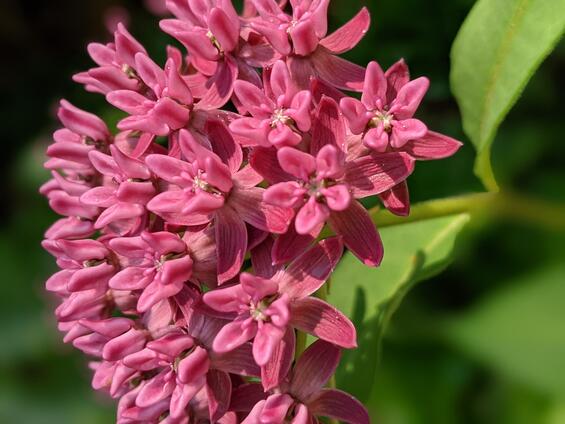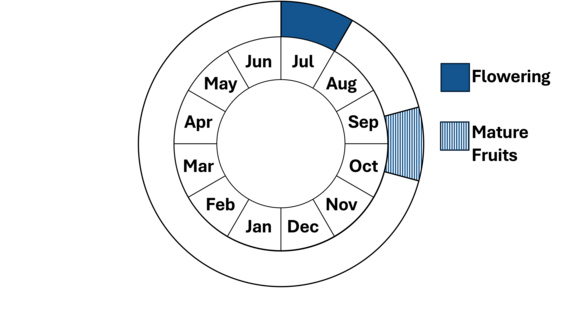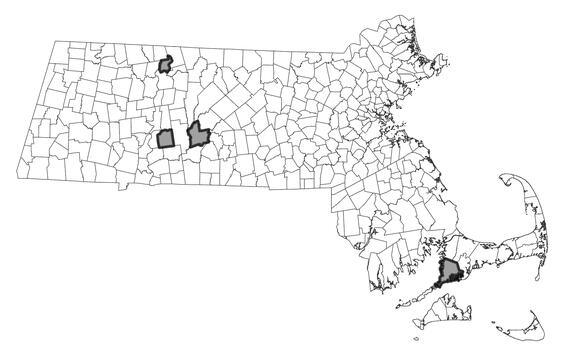- Scientific name: Asclepias purpurascens L.
- Species of Greatest Conservation Need (MA State Wildlife Action Plan)
- Endangered (MA Endangered Species Act)
Description

Purple milkweed. Photo credit: Robert Wernerehl
Purple milkweed (Family Apocynaceae) is an herbaceous perennial of open, sparsely-vegetated woodlands and borders. Unlike other milkweeds this species produces stems only from a confined crown and does not “run”or spread by rhizomes. The flowers are produced in one to two hemispherical umbels of showy, deep purple to reddish-magenta flowers from late June to August. Like other members of its family, it has milky sap or latex. The stems can be smooth or covered in minute down and areup to one meter 1 m (3.3 ft) tall. The opposite, ovate-oblong to elliptic leaves are dark green and have a smooth upper surface and a pale, hairy lower surface. Flowers can produce two follicles (fruits) each, but typically only one or two are produced per umbel, if any fruit is set at all. Wind dispersal of the seeds is enabled by the silky hairs attached to them.
The most prominent feature of this species is its large purple flowers with large, tall upward pointing petal appendages, or hoods. Another diagnostic feature is its smooth downward pointing fruits.The leaves taper to a short petiole, 0.8-2.5 cm (0.3-0.9 inches) long, and have an acute tip. Leaf mid-veins of this species are often pinkish. Additionally, inflorescences are generally terminal in purple milkweed.
Purple milkweed can be confused with tall milkweed (Asclepias exaltata),common milkweed (Asclepias syriaca), and swamp milkweed (Asclepias incarnata). Tall milkweed, as its name suggests, is often taller, up to 2m (~6ft), and has whitish to greenish flowers. Swamp milkweed has smaller flowers arranged in a flat cluster and often has more pubescent upper leaf surfaces. Common milkweed’s flowers are lighter purple and its leaves are blunt ended with a distinct separate point, while purple milkweed leaves simply taper to a narrow tip. In fruit, purple and common milkweeds have reflexed peduncles (flowering stalks), while in swamp and tall milkweeds peduncles are erect. The smooth fruit of purple milkweed can be used to distinguish it from the warty fruit of common milkweed. An additional character for vegetative material is that the leaves of the purple milkweed are not as prominently pinnate-veined as those of common milkweed. Tall and purple milkweeds can be very difficult to distinguish from vegetative material, but generally tall milkweed has longer leaves; flowers or fruit may be necessary for conclusive identification.

Population status
Purple milkweed is listed as endangered under the Massachusetts Endangered Species Act. All listed species are protected from killing, collecting, possessing, or sale and from activities that would destroy habitat and thus directly or indirectly cause mortality or disrupt critical behaviors. Historically, purple milkweed was found in all but Bristol and Plymouth counties. There are 5 populations that have been verified since 1999 in Barnstable, Dukes, Franklin, and Hampshire Counties.
Distribution and abundance
Purple milkweed can be found in much of the eastern half of the United States as far west as South Dakota and Texas. It also occurs in Southern Ontario. Despite the wide range, the species is possibly extirpated from Mississippi, New Hampshire, and Rhode Island and is considered critically imperiled in both southern states, Georgia, Louisiana, North Carolina, Oklahoma and Tennessee as well as northern states, Massachusetts and southern Ontario. It is considered imperiled in Connecticut and New York.

Distribution in Massachusetts
1999-2024
Based on records in the Natural Heritage Database
Habitat
Purple milkweed is usually found on dry, fairly open road banks and in drier oak-pine woods and woodland borders. However, it is a facultative wetland species and has been found along scrubby lakeshores and in vernal pools.
Healthy habitats are vital for supporting native wildlife and plants. Explore habitats and learn about conservation and restoration in Massachusetts.
Threats
This is an early to mid-successional species; tree growth and the resulting reduction in light may contribute to mortality. One population in Massachusetts has been critically endangered by development. Some populations may be threatened by deer browsing. As the existing populations are small, failure of sexual reproduction due to self-incompatibility or inbreeding depression may also contribute to population decline.
Conservation
Research needs
Documented populations need to be protected from the effects of development, succession, erosion and recreation. Lack of other individuals for cross pollination is an issue at one location; supplemental pollen may be needed for sexual reproduction. There should bequantitative monitoring undertaken at all known sites. All active management of rare plant populations (including invasive species removal) is subject to review under the Massachusetts Endangered Species Act and should be planned in close consultation with the NHESP.
References
Choberka, E.G., M.R. Penskar, and P.J. Higman. 2000. Special plant abstract for Asclepias purpurascens (purple milkweed). Michigan Natural Features Inventory, Lansing, MI. 2 pp.
Farnsworth, E.J., and M.J. DiGregorio. 2002. Asclepias purpurascens L. (purplemilkweed) Conservation and Research Plan. New England Plant Conservation Program, Framingham, Massachusetts, USA.
Contact
| Date published: | April 7, 2025 |
|---|